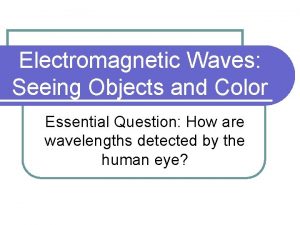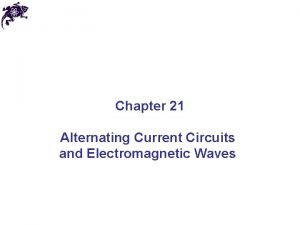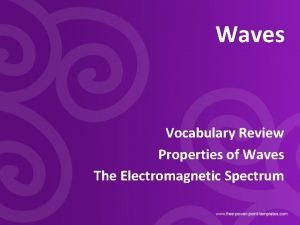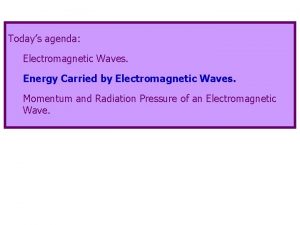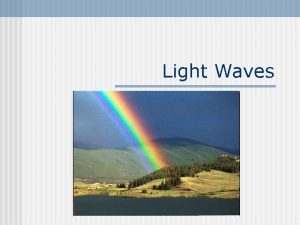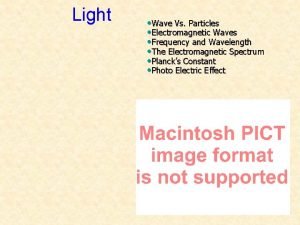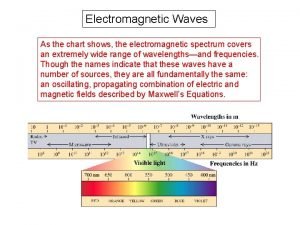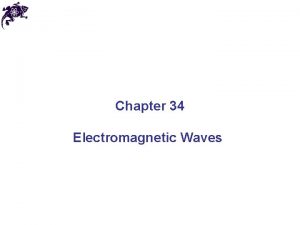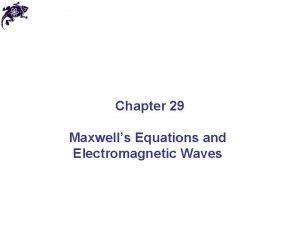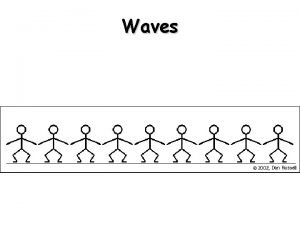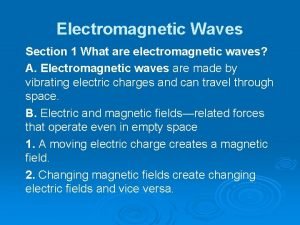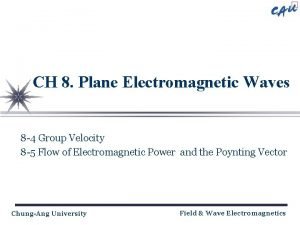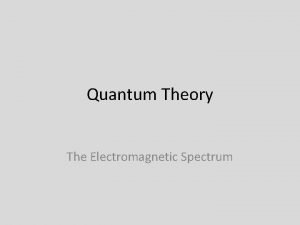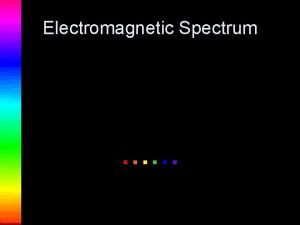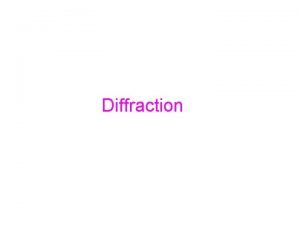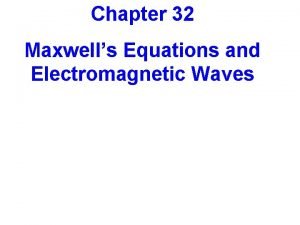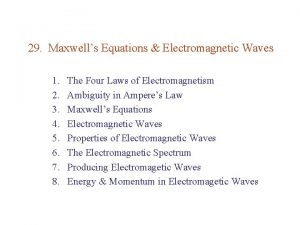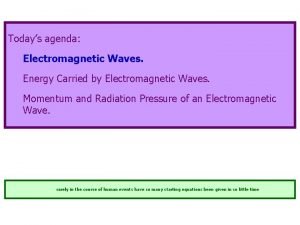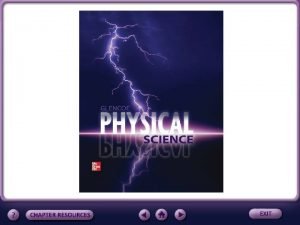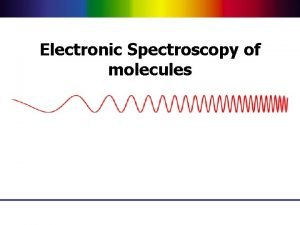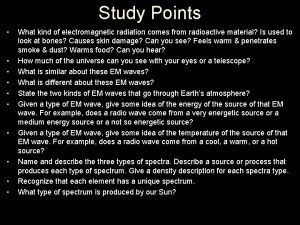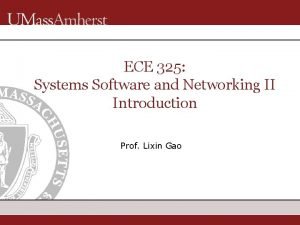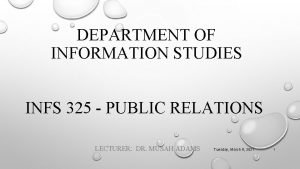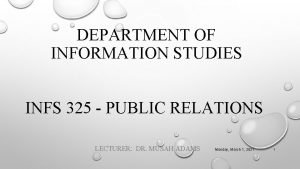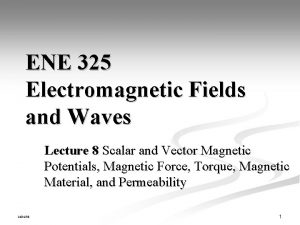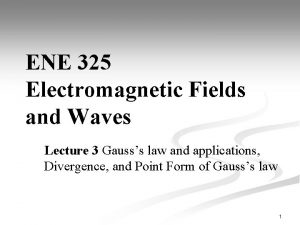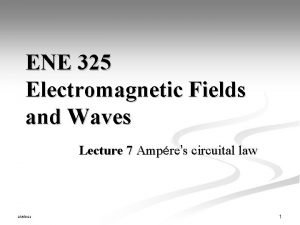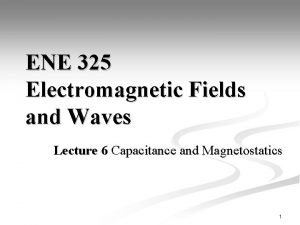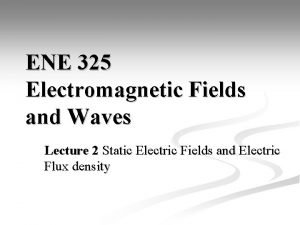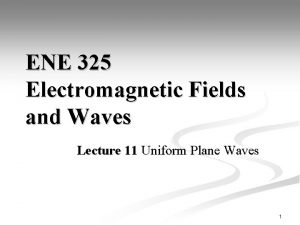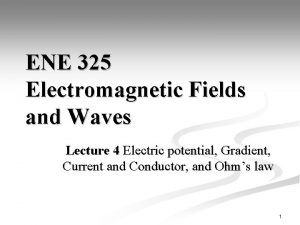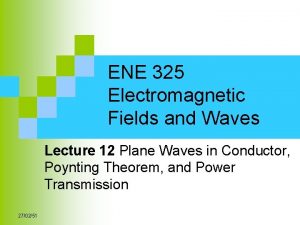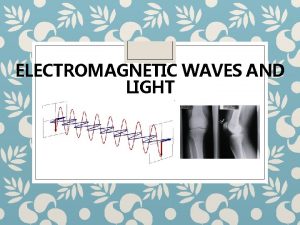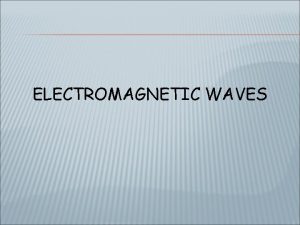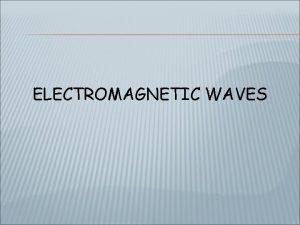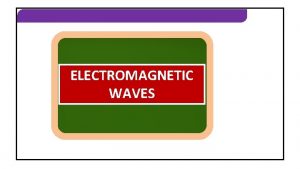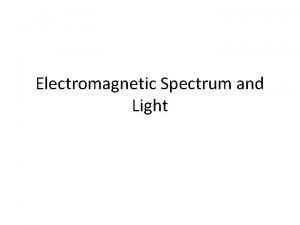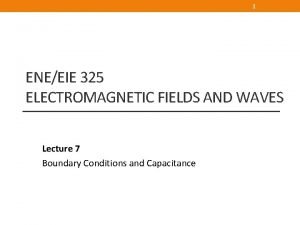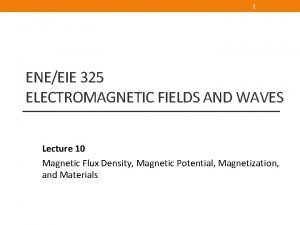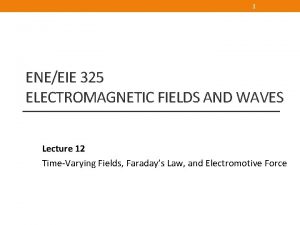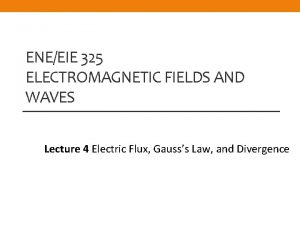ENE 325 Electromagnetic Fields and Waves LECTURE 1















































- Slides: 47

ENE 325 Electromagnetic Fields and Waves LECTURE 1 INTRODUCTION ON ELECTROSTATICS AND VECTOR MANIPULATION http: //youtu. be/P_Jt. U 0 d. KITE

Syllabus � Asst. Prof. Dr. Thorin Theeradejvanichkul, sie 4129@hotmail. com � Lecture: Thai: 9: 30 am-12: 20 pm Monday, Rm. CB 41002 Inter: 9: 30 am-12: 20 pm Tuesday, Rm. CB 41004 Download lectures at http: //sv 1. myle. kmutt. ac. th � Office hours : by appointment � Textbook: W. Hayt and J. Buck, Engineering Electromagnetics, 8 th edition, Mc. Graw. Hill Education, 2011 2

Course Objectives 3 This is the course on beginning level electrodynamics. To provide junior electrical engineering students with the fundamental methods to analyze and understand electromagnetic field problems that arise in various branches of engineering science. Vision: Providing opportunities for intellectual growth in the context of an engineering discipline for the attainment of professional competence, and for the development of a sense of the social context of technology.

Prerequisite knowledge and/or skills 4 �Basic physics background relevant to electromagnetism : charge, force, SI system of units; basic differential and integral vector calculus �Concurrent study of introductory lumped circuit analysis �MTH 201

Grading system 5 � Quiz � Midterm exam � Final exam 20% 40%

Quiz group arrangement

What is the electromagnetic field? 7 � Electro + Magnetic = Electromagnetic � The disturbance that propagates in the combined form of electric and magnetic fields.

Examples of Electromagnetic fields 8 � Electromagnetic fields � Solar radiation � Lightning � Radio communication � Microwave oven http: //planetfacts. org/wp-content/uploads/2011/03/solar-radiation. jpg http: //img. gawkerassets. com/img/17 wl 4 kpeam 089 jpg/original. jpg http: //www. meder. com/uploads/pics/Radio_Communication. gif http: //greenprophet. com/wp-content/uploads/2008/08/microwave-oven-danger-illustration. jpg

Light consists of electric and magnetic fields. An electromagnetic wave can propagate in a vacuum with a speed velocity c =2. 998 x 108 m/s f = frequency (Hz) = wavelength (m) http: //www. dicts. info/img/ud/a/amplitude. png c = f 9

Units 10 Symbol Name SI unit Abbreviation r, R distance meter m t time second s E Electric field intensity volt/meter V/m Q Electric charge coulomb C F Force newton N 0 , Permittivity farad/meter F/m

Electrostatics Topics 11 PREPARED BY Dr. Werapon Chiracharit � Review � What is electrostatics � Electrostatics phenomena � Transfer of charge � Insulators and conductors � Polarization � Electrostatic generator � Electrostatic discharge � Applications of static electricity � Electrostatic charge conclusion � Coulomb’s law � Fields and forces � Superposition of forces

Review : quantized charge 12 electron proton neutron Charge -e +e 0 Mass 1 1836 1839 positron +e 1 � q = multiple of an elementary charge e � e = 1. 6 x 10 -19 C Diameter ~10 -18 m ~10 -15 m ~10 -18 m

What is Electro. Statics? 13 Electrostatics is the phenomena and properties of stationary or slow-moving electric charges with no acceleration. Electrostatic phenomena arise from the forces that electric charges exert on each other.

Electrostatics phenomena (1) 14 Since classical antiquity, it has been known that some materials such as amber attract lightweight particles after rubbing (e. g. with fur). The Greek word for amber, ήλεκτρον (elektron), was the source of the word 'electricity'.

Transfer of charge SILK Glass Rod Some materials attract electrons more than others. 15

Transfer of charge + - SILK Glass Rod As the glass rod is rubbed against silk, electrons are pulled off the glass onto the silk. 16

Transfer of charge + + - SILK Glass Rod Usually matter charge is neutral, because the number of electrons and protons are equal. But here the silk has an excess of electrons and the rod a deficit. 17

Transfer of charge 18 + + - + + + SILK Glass Rod Glass and silk are insulators: charges stuck on them stay put. What materials tend to give up/attract electrons when brought in contact with other materials? Why?

Insulators and Conductors Insulators In insulators, electrons are bound in “orbit” to the nucleus in each atom. When charge is placed on an insulator, it stays in one region and does not distribute. Wood, plastic, glass, air, and cloth are good insulators. CHARGED INSULATOR Conductors In conductors electrons can move from atom to atom, thus electricity can “flow”. When charge is placed on a conductor, it redistributes to the outer surface. Metals (copper, gold, and aluminum) are good conductors. CHARGED CONDUCTOR 19

Polarization is the separation of charge In a conductor, “free” electrons can move around the surface of the material, leaving one side positive and the other side negative. In an insulator, the electrons “realign” themselves within the atom (or molecule), leaving one side of the atom positive and the other side of the atom negative. Polarization is not necessarily a charge imbalance! 20

Electrostatic generator 21 Van de Graaff generator http: //www. youtube. com/watch? v=WS 9 ISUXBsa 8 https: //www. youtube. com/watch? v=rpy. HFMwa. NDM

Electrostatics discharge (1) 22

Electrostatics discharge (2) Grounding: connecting an object to a large body, like Earth, that is capable of removing any electric charge on the object

Applications of static electricity (1) Electrostatic Spray Painting: positively charge the object and negatively charge the paint particles opposite charges attract http: //youtu. be/LAEGkaq. KZh. Q -paint particles are attracted to the object and less is lost as over spray

Applications of static electricity (2) Electrostatic Duster: rubbing the duster across a surface causes the duster to become charged by friction. -neutral dust particles stick to charged duster

Applications of static electricity (3) Electrostatic Precipitator: a device to remove dust particles from the exhaust gas from industry http: //youtu. be/LYvs 8 w 9 Ccv. M

Applications of static electricity (4) Photocopying: selenium is an insulator but becomes a conductor when exposed to light. http: //youtu. be/3 w. Da. OAp 31 Bo

Applications of static electricity (5) 28 Capacitor: � A capacitor can be charged by connecting it to a battery or any other source of current. � A capacitor can be discharged by connecting it to any closed circuit that allows current to flow. http: //www. wisc-online. com/objects/View. Object. aspx? ID=ACE 11805 http: //www. doitpoms. ac. uk/tlplib/dielectrics/capacitors. php

Electrostatic charge conclusion 29 • Objects can lose or gain electric charges. • The net charge is also sometimes called excess charge because a charged object has an excess of either positive or negative charges. • A tiny imbalance in either positive or negative charge on an object is the cause of static electricity. • The electrostatic forces are described by Coulomb's law.

Coulomb’s law (1) � Charles-Augustin de Coulomb (14 June 1736 – 23 August 1806) was a French physicist. � He was best known for developing Coulomb's law, the definition of the electrostatic force of attraction and repulsion. � The SI unit of electric charge, the coulomb, was named after him. 30

Coulomb’s law (2) The magnitude of the electrostatics force of interaction between two point charges is directly proportional to the scalar multiplication of the magnitudes of charges (q 1 and q 2) and inversely proportional to the square of the distances (r 2) between them. 31

Coulomb's law (3) 32 �The force between two charges gets stronger as the charges move closer together. �The force also gets stronger if the amount of charge becomes larger. http: //webphysics. davidson. edu/physlet_resources/bu_semester 2/c 01_magnitude. html

Fields and forces (1) 33 � The concept of a field is used to describe any quantity that has a value for all points in space. � You can think of the field as the way forces are transmitted between objects. � Charge creates an electric field that creates forces on other charges.

Fields and forces (2) 34 Comparing to gravitational force

Fields and forces (3) 35 �Mass creates a gravitational field that exerts forces on other masses.

Fields and forces (4) 36 �Gravitational forces are far weaker than electric forces.

Fields and forces (5) 37

Fields and forces (6) 38 +Q

Fields and forces (7) 39 +Q Test charge +q

Fields and forces (8) �Definition of Electric field: 40

http: //www. dgp. toronto. edu/~mjmcguff/research/electrostatic/applet 1/main. html http: //www. cco. caltech. edu/~phys 1/java/phys 1/EField. html 41

Superposition of forces from two charges Blue charges fixed , negative, equal charge (-q) What is force on positive red charge +q ? y x

Superposition of forces from two charges Blue charges fixed , negative, equal charge (-q) What is force on positive red charge +q ? Consider effect of each charge separately: y x

Superposition of forces from two charges Blue charges fixed , negative, equal charge (-q) What is force on positive red charge +q ? Take each charge in turn: y x

Superposition of forces from two charges Blue charges fixed , negative, equal charge (-q) What is force on positive red charge +q ? Create vector sum: y x

Superposition of forces from two charges Blue charges fixed , negative, equal charge (-q) What is force on positive red charge +q ? Find resultant: y NET FORCE x http: //www. rmutphysics. com/charud/virtualexperiment/Explore/Interaction. EC/index. htm

Interesting Links • http: //www. cco. caltech. edu/~phys 1/java/phys 1/EField. html • http: //www. dgp. toronto. edu/~mjmcguff/research/electrostatic/appl et 1/main. html • http: //webphysics. davidson. edu/physlet_resources/bu_semester 2/c 01_magnitude. html • http: //www. colorado. edu/physics/2000/applets/orbits. html • http: //www. rmutphysics. com/charud/virtualexperiment/Explore/Int eraction. EC/index. htm
 Alcohol formula
Alcohol formula Mechanical waves examples
Mechanical waves examples Examples of mechanical waves
Examples of mechanical waves Transfer of energy when a wave disappears into a surface
Transfer of energy when a wave disappears into a surface Difference between matter waves and electromagnetic waves
Difference between matter waves and electromagnetic waves Mechanical waves and electromagnetic waves similarities
Mechanical waves and electromagnetic waves similarities Mechanical waves vs electromagnetic waves venn diagram
Mechanical waves vs electromagnetic waves venn diagram Longitudinal wave vs transverse wave
Longitudinal wave vs transverse wave Mechanical waves vs electromagnetic waves
Mechanical waves vs electromagnetic waves Red fields
Red fields Electromagnetic waves: seeing objects and color
Electromagnetic waves: seeing objects and color Alternating current circuits and electromagnetic waves
Alternating current circuits and electromagnetic waves Compare and contrast p waves and s waves using venn diagram
Compare and contrast p waves and s waves using venn diagram Electromagnetic waves vocabulary
Electromagnetic waves vocabulary Energy density of electric field
Energy density of electric field Electromagnetic waves characteristics
Electromagnetic waves characteristics Electromagnetic waves frequency
Electromagnetic waves frequency Electro magnetic spectrum chart
Electro magnetic spectrum chart Electromagnetic waves template
Electromagnetic waves template Electromagnetic waves obey principle of .. *
Electromagnetic waves obey principle of .. * Teoria de james maxwell
Teoria de james maxwell Electromagnetic energy
Electromagnetic energy Electromagnetic waves song lyrics
Electromagnetic waves song lyrics Section 1 what are electromagnetic waves
Section 1 what are electromagnetic waves Electromagnetic wave power
Electromagnetic wave power Conclusion of electromagnetic waves
Conclusion of electromagnetic waves Electron spectrum
Electron spectrum Electromagnetic waves in water
Electromagnetic waves in water Electromagnetic waves formulas
Electromagnetic waves formulas Direction of electromagnetic waves
Direction of electromagnetic waves Concept of electromagnetic waves
Concept of electromagnetic waves Energy carried by electromagnetic waves
Energy carried by electromagnetic waves Elextromagnetic spectrum
Elextromagnetic spectrum Section 1 what are electromagnetic waves
Section 1 what are electromagnetic waves Electromagnetic spectrum table
Electromagnetic spectrum table What type of electromagnetic waves cause sunburns? *
What type of electromagnetic waves cause sunburns? * What is a semiconductor used for
What is a semiconductor used for Surface waves and body waves
Surface waves and body waves What are constructive waves
What are constructive waves 01:640:244 lecture notes - lecture 15: plat, idah, farad
01:640:244 lecture notes - lecture 15: plat, idah, farad The wave chapter 13
The wave chapter 13 Whats a reflected sound wave
Whats a reflected sound wave Seismic waves are mechanical waves
Seismic waves are mechanical waves Ece 325
Ece 325 Apes 325 template
Apes 325 template Infs 325
Infs 325 Semdr communication model
Semdr communication model Infs 325
Infs 325










